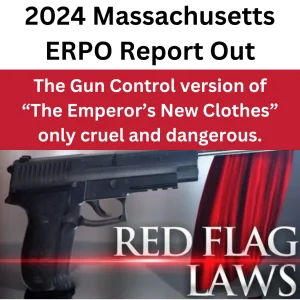
By Jim Wallace
Executive Director, Massachusetts GOAL
Special to TGM
The Massachusetts Trial Court has just released its 2024 report on Extreme Risk Protection Orders (ERPOs).
These annual reports are required under Section 131Y of Chapter 123 of the Acts of 2018. The report concerns 24 ERPOs for the year 2024, but the way the data is presented is rather confusing.
Generally, there are two reasons why an ERPO is filed. The first is someone who may be a harm to themselves (suicidal). The other is someone who may be a harm to others (the next mass murderer). No where in the report does it break down why the ERPO was filed in the first place.
Another major bit of missing information is what happened after an ERPO was approved. It does present how many instances “items surrendered”, which itself is an interesting term. What is conspicuous by its absence is any follow-up by the courts or state agencies.
If someone was determined to be a possible spree killer, other than take away their gun license and firearms, what following action took place? Were they referred for a dangerousness hearing? How about a 72 hour mental health evaluation, often called a Section 12? What job do they have, do they work in a school, how about driving tractor trailers full of chemicals? If this person was indeed a legitimate threat, then why the missing data?
How about if someone was legitimately found to be a threat suicide threat? What was the follow up? According to the latest Massachusetts suicide data, in 2022 there were 253 suicides by hanging compared to 146 by firearm. There were also 140 suicides by poison. So if a court simply takes away a person’s firearm license and guns with no follow up, has the situation actually improved?
Another missing piece is what type of person filed the petition? The report does break it down by gender, race, and ethnicity, but for the most part that is “unreported”. Why is this important data?
In the most recent ERPO law upgrade in Chapter 135 of the Acts of 2024 the list of persons who could file a petition was greatly expanded. People added to the potential petitioners were, doctors, nurses, therapists, marriage counselors, social workers, and more. If these additions were so vital, why would the Courts not be tracking which group initiated the action?
The bottom line is that the report itself reflects the uselessness of the entire ERPO system itself. The entire system is a huge piece of law that virtually has no impact on public safety. Aside from being totally unconstitutional, the ERPO system is the gun control version of “The Emperor’s New Clothes”. Only cruel and dangerous.
GOAL’s review of the new ERPO laws: https://www.goal.org/redflag



